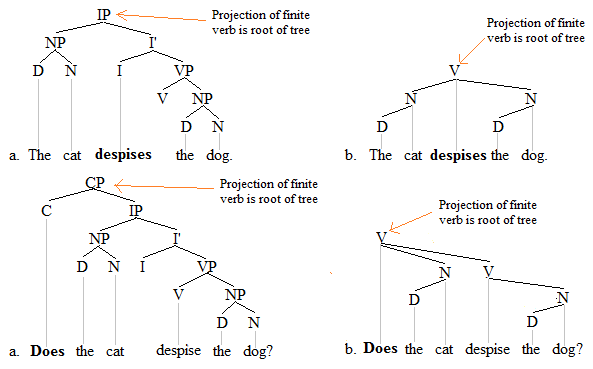Finite verb
A finite verb is the form of a
etc.History
The term finite is derived from
More recently, finite verbs have been construed as any verb that independently functions as a
Examples
In the following sentences, the finite verbs are emphasized, while the non-finite verb forms are underlined.
- Verbs appear in almost all sentences.
- This sentence is illustrating finite and non-finite verbs.
- The dog will have to be trained well.
- Tom promised to try to do the work.
- The case has been intensively examined today.
- What did they want to have done about that?
- Someone tried to refuse to accept the offer.
- Coming downstairs, she saw the man running away.
- I am trying to get the tickets.
In many languages (including English), there can be one finite verb at the root of each clause (unless the finite verbs are coordinated), whereas the number of non-finite verb forms can reach up to five or six, or even more, e.g.
- He was believed to have been told to have himself examined.
Finite verbs can appear in dependent clauses as well as independent clauses:
- John said that he enjoyed reading.
- Something you make yourself seems better than something you buy.
Most types of verbs can appear in finite or non-finite form (and sometimes these forms may be identical): for example, the
It might seem that every grammatically complete sentence or
A finite verb is generally expected to have a
- Come over here!
- Don't look at him!
And also occur in some fragmentary utterances with an
- [It] Doesn't matter.
- [I] Don't want to go.
Grammatical categories
The relatively limited system of inflectional morphology in English often obscures the central role of finite verbs. In other languages, finite verbs are the locus of much grammatical information. Depending on the language, finite verbs can inflect for the following grammatical categories:
- Gender, i.e. masculine, feminine or neuter.
- Person, e.g. 1st, 2nd, or 3rd (I/we, you, he/she/it/they).
- Number, e.g. singular or plural (or dual).
- Tense, i.e. present, past or future.
- Aspect, e.g. perfect, perfective, progressive, etc.
- Mood, e.g. indicative, subjunctive, imperative, optative, etc.
- Voice, i.e. active, middle, or passive.
The first three categories represent
Modern English is an analytic language (Old English is frequently presented as a synthetic language), which means it has limited ability to express the categories by verb inflection, and it often conveys such information periphrastically, using auxiliary verbs. In a sentence such as
- Sam laughs a lot,
the verb form agrees in person (3rd) and number (singular) with the subject, by means of the -s ending, and this form also indicates tense (present), aspect ("
- Sam will have been examined by this afternoon.
Here the auxiliaries will, have and been express respectively future time, perfect aspect and passive voice. (See
Theories of syntax
Finite verbs play a particularly important role in syntactic analyses of sentence structure. In many phrase structure grammars for instance those that build on the X-bar schema, the finite verb is the head of the finite verb phrase and so it is the head of the entire sentence. Similarly, in dependency grammars, the finite verb is the root of the entire clause and so is the most prominent structural unit in the clause. That is illustrated by the following trees:
The phrase structure grammar trees are the a-trees on the left; they are similar to the trees produced in the
See also
References
- ^ Concerning the manifestation of a subject as an important criterion for identifying finite verbs, see Radford (1997:507f.).
- ^ "finite, adj. and n." Oxford English Dictionary.
- ISBN 978-0-19-967512-8.
- ^ Concerning nominal sentences in old Indo-European languages, see Fortson (2004:143).
- ^ On such trees, see, for instance, Cowper (1992) and Haegeman (1994).
- ^ On such dependency trees, see, for instance, Eroms (2000).
Sources
- Greenbaum, S. and R. Quirk. 1990. A student's grammar of the English language. Harlow, Essex, England: Longman.
- Cowper, E. 2009. A concise introduction to syntactic theory: The government-binding approach. Chicago: The University of Chicago Press.
- Downing, A. and P. Locke. 1992. English grammar: A university course, second edition. London: Routledge.
- Eroms, H.-W. 2000. Syntax der deutschen Sprache. Berlin: de Gruyter.
- Finch, G. 2000. Linguistic terms and concepts. New York: St. Martin's Press.
- Fortson, B. 2004. Indo-European Language and Culture. Blackwell Publishing.
- Haegeman, L. 1994. Introduction to government and binding theory, 2nd edition. Oxford, UK: Blackwell.
- Klammer, T. and M. Schulz. 1996. Analyzing English grammar. Boston: Allyn and Bacon.
- Oxford English Dictionary 1795. "finite [...] Of a verb: limited by number and person.
- Quirk, R. S. Greenbaum, G. Leech, and J. Svartvik. 1979. A grammar of contemporary English. London: Longman.
- Radford, A. 1997. Syntactic theory and the structure of English: A minimalist approach. Cambridge, UK: Cambridge University Press.

